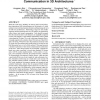Free Online Productivity Tools
i2Speak
i2Symbol
i2OCR
iTex2Img
iWeb2Print
iWeb2Shot
i2Type
iPdf2Split
iPdf2Merge
i2Bopomofo
i2Arabic
i2Style
i2Image
i2PDF
iLatex2Rtf
Sci2ools
ISCA
2007
IEEE
2007
IEEE
A novel dimensionally-decomposed router for on-chip communication in 3D architectures
Much like multi-storey buildings in densely packed metropolises, three-dimensional (3D) chip structures are envisioned as a viable solution to skyrocketing transistor densities and burgeoning die sizes in multi-core architectures. Partitioning a larger die into smaller segments and then stacking them in a 3D fashion can significantly reduce latency and energy consumption. Such benefits emanate from the notion that inter-wafer distances are negligible compared to intra-wafer distances. This attribute substantially reduces global wiring length in 3D chips. The work in this paper integrates the increasingly popular idea of packet-based Networks-on-Chip (NoC) into a 3D setting. While NoCs have been studied extensively in the 2D realm, the microarchitectural ramifications of moving into the third dimension have yet to be fully explored. This paper presents a detailed exploration of inter-strata communication architectures in 3D NoCs. Three design options are investigated; a simple busba...
Cycle-accurate 3d Noc | Hardware | Hybrid 3d Noc/cache | ISCA 2007 | Partially-connected 3D Crossbar |
| Added | 03 Jun 2010 |
| Updated | 03 Jun 2010 |
| Type | Conference |
| Year | 2007 |
| Where | ISCA |
| Authors | Jongman Kim, Chrysostomos Nicopoulos, Dongkook Park, Reetuparna Das, Yuan Xie, Narayanan Vijaykrishnan, Mazin S. Yousif, Chita R. Das |
Comments (0)

